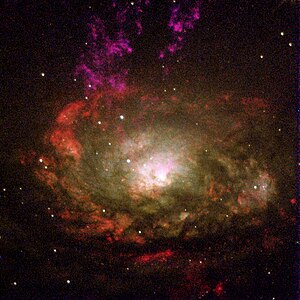Circinus Galaxy
| Circinus Galaxy | |
|---|---|

|
|
| Observation data (J2000 epoch) | |
| Constellation | Circinus |
| Right ascension | 14h 13m 9.9s |
| Declination | −65° 20′ 21″ |
| Redshift | 426 ± 25 km/s |
| Distance | 13 Mly |
| Apparent magnitude (V) | 12.1 |
| Characteristics | |
| Type | SA(s)b |
| Apparent size (V) | 6′.9 × 3′.0 |
| Other designations | |
| ESO 97-G13, LEDA 50779 | |
The Circinus Galaxy (ESO 97-G13) is a Seyfert galaxy in the Circinus constellation. It is located 4 degrees below the Galactic plane, and, at a distance of 13 million light-years, it is one of the closest to the Milky Way. The galaxy is undergoing tumultuous changes, as rings of gas are being ejected from the galaxy. The outermost ring is 700 light-years from the center of the galaxy and the inner ring is 130 light-years out. Although the Circinus galaxy can be seen using a small telescope, it was not noticed until 1977 because it lies close to the plane of the Milky Way and is obscured by galactic dust. The Circinus Galaxy is a Type II Seyfert galaxy and is one of the closest known active galaxies to the Milky Way, though it is probably slightly further away than Centaurus A.
Circinus Galaxy was a home for SN 1996cr, that has been identified over a decade after it exploded. The supernova was first singled out in 2001 as a bright, variable object in a Chandra X-ray Observatory image, but it was not confirmed as a supernova until years later.
The Circinus Galaxy is one of twelve large galaxies (the "Council of Giants") surrounding the Local Group in the Local Sheet.
Coordinates: ![]() 14h 13m 9.9s, −65° 20′ 21″
14h 13m 9.9s, −65° 20′ 21″
...
Wikipedia
